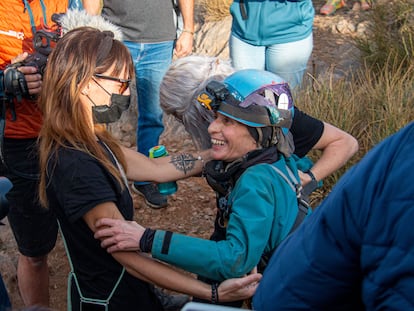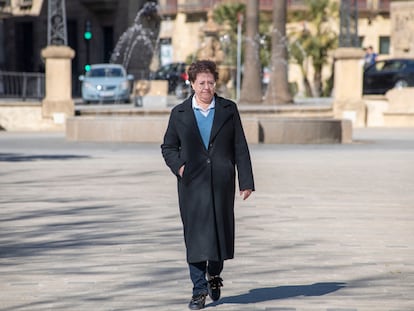The epicenter of Spain’s drought: 134 days without rain
The barren-looking municipality of Tomelloso has lost all its cereal crops and is now struggling to save its vineyards, which had traditionally kept growers afloat when everything else failed: ‘The situation is really bad’
It is still spring and, as he stretches the irrigation pipes between the vines, it occurs to José Antonio Martínez Lara, 49, that he has already lived through a similar scenario. His father, Patricio, 75, is driving the tractor. He refuses to stay at home after a lifetime working the land, partly because he fears the worst. Patricio’s 17-year-old grandson, also called José Antonio, was not yet born during the last great drought that lasted between 1991 and 1995.
The Martínez family are trying to save their vineyards using drip irrigation because there has been no rain in the municipality of Tomelloso, in the Spanish province of Ciudad Real, for 134 days. They have already lost the entire cereal harvest, worth €25,000 ($27,500). With the lowest rainfall in the whole of Spain this year, the district’s inhabitants, mainly farmers, spend their lives looking upwards. They are at the epicenter of the drought.
Tomelloso has approximately 36,000 inhabitants and more than 23,000 hectares of vineyards, as well as fields of barley, olives, almonds and melons. It also has the largest wine cooperative in the world — the Virgen de las Viñas, with almost 3,000 members. The vineyards have generally come to the rescue and paid off any debts racked up by other crops. After a good harvest, plots of land have been bought, machinery purchased, and facilities changed. The vineyards meant money, something that cannot be said today.
The president of the cooperative, Rafael Torres, says that he is “deeply worried” and that “the situation is really bad,” — that after the pandemic and the war in Ukraine, which caused the cost of fertilizer, diesel and phytosanitary products to soar, all that was missing was a drought. “It’s the last straw,” says José Antonio Martínez from his vineyard on the outskirts of town. When it comes to farming, the only forecasts that matter are weather forecasts — not those of large financial institutions.
The rainfall here this year has been less than half of what usually slakes the thirst of this arid land. However, they are so accustomed to dry weather that the native grape variety, Airén, used mainly for white wine, is particularly drought resistant. But it has its limits. That is why the Martínez family is laying the irrigation pipes among the low vines. They have turned on the tap early. It is unheard of to be irrigating in April and they don’t know if the permitted quota of water will last until August. But there’s no alternative.
There is the water that falls from the sky and then there is the water concealed underground. Everyone is aware that in the region of La Mancha, there have always been landowners and aguatenientes — water deputies as the residents call them. Twenty to 30 meters below the dusty furrows, there are enough waterways to irrigate and multiply production for all those suffering above ground. But since 1995, illegal wells and the amount of water each farmer can use has been strictly controlled. And if it doesn’t rain, the quota is not enough.
Now, as the drought is discussed in the coffee shops and bars, and in front of the pristine white Town Hall, there is an image that stays with you — that of the Peñarroya reservoir, about 15 kilometers from Tomelloso, which is almost overflowing. In late April, groups of young people splash about in its crystal-clear waters. Official data confirm it is at 86% of its capacity, in the driest period in almost three decades. “How is that possible?” ask a handful of pensioners in the village who appear to consider the origins of the reservoir’s water a mystery.
“Peñarroya is filled by the Lagunas de Ruidera,” explains the president of the Federation of Irrigators of Castilla-La Mancha, Herminio Molina. “The water is filtered in the aquifers of the Campo de Montiel and is discharged due to gravity into the lagoons, which are protected by many restrictions. Once the lagoons go through their natural cycle, they discharge through the last lagoon which is the reservoir. The water empties into it and accumulates.” The reservoir irrigates some 8,000 hectares of the surrounding municipalities, including Tomelloso.
The irrigated crops in the district, which account for about half of the total, are watered from aquifer 23 and the Peñarroya reservoir. The limit for those who irrigate with groundwater is 1,350 cubic meters per hectare and about 3,000 for those who, like the Martínez family, are supplied from the reservoir.
“Practically all the cereals have been lost in the area — those dependent on rain,” Torres explains. Crops such as José Antonio’s, which involve an investment of about €800 per hectare, are no longer salvageable, even if it rains in the next month. The agricultural unions are seeking to apply for direct aid from the regional government to compensate for their losses. “To continue working this dry land already has more to do with sentimentality than anything else,” Torres adds.
A few kilometers from José Antonio’s vineyard, another farmer, Hilario Díaz, 73, rakes his hand through the soil between his trellised vines. “Look, there’s not a single living root. Not a drop of moisture. No matter where you look it’s dry,” he says. He has drip irrigation using groundwater, but like the rest, he has to calculate the precise amount so as not to exhaust his quota before August. The high temperatures expected this week are not helping. And the vines are looking the worse for wear. He points out the lack of buds, the dry shoots. “This is a disaster,” he says.
The Martínez family has 200 hectares of crops in the area. They actually hail from another even drier municipality, La Solana, but they gradually migrated here, accumulating a quantity of loans and sweat. Patricio acknowledges his farm is large given he is the only son of a shepherd. And it is only now, at 75, that he has learned to enjoy holidays. Previously, when his son proposed visiting Cádiz, he replied: “I don’t know if I’ll know how to be a tourist.”
José Antonio turns grim as he takes off his straw hat. He recalls that in 1995, he had to pull up the vines and take a job at a gas station and another job loading melons. “It was a period that left me traumatized, as you city people would put it,” he says. “And I’m seeing the same thing happening, the same thing...” His son, the eldest of three, has given up his plans to complete a mechanics course in order to join his father and grandfather on the farm. When the young man walks away, his father says sadly: “I think it was a mistake. I don’t know how he’s going to make a living out of this. I don’t want him to live what I have lived through.”
Sign up for our weekly newsletter to get more English-language news coverage from EL PAÍS USA Edition
Tu suscripción se está usando en otro dispositivo
¿Quieres añadir otro usuario a tu suscripción?
Si continúas leyendo en este dispositivo, no se podrá leer en el otro.
FlechaTu suscripción se está usando en otro dispositivo y solo puedes acceder a EL PAÍS desde un dispositivo a la vez.
Si quieres compartir tu cuenta, cambia tu suscripción a la modalidad Premium, así podrás añadir otro usuario. Cada uno accederá con su propia cuenta de email, lo que os permitirá personalizar vuestra experiencia en EL PAÍS.
¿Tienes una suscripción de empresa? Accede aquí para contratar más cuentas.
En el caso de no saber quién está usando tu cuenta, te recomendamos cambiar tu contraseña aquí.
Si decides continuar compartiendo tu cuenta, este mensaje se mostrará en tu dispositivo y en el de la otra persona que está usando tu cuenta de forma indefinida, afectando a tu experiencia de lectura. Puedes consultar aquí los términos y condiciones de la suscripción digital.
More information
Archived In
Últimas noticias
Most viewed
- Sinaloa Cartel war is taking its toll on Los Chapitos
- Reinhard Genzel, Nobel laureate in physics: ‘One-minute videos will never give you the truth’
- Oona Chaplin: ‘I told James Cameron that I was living in a treehouse and starting a permaculture project with a friend’
- Why the price of coffee has skyrocketed: from Brazilian plantations to specialty coffee houses
- David King, chemist: ‘There are scientists studying how to cool the planet; nobody should stop these experiments from happening’











































